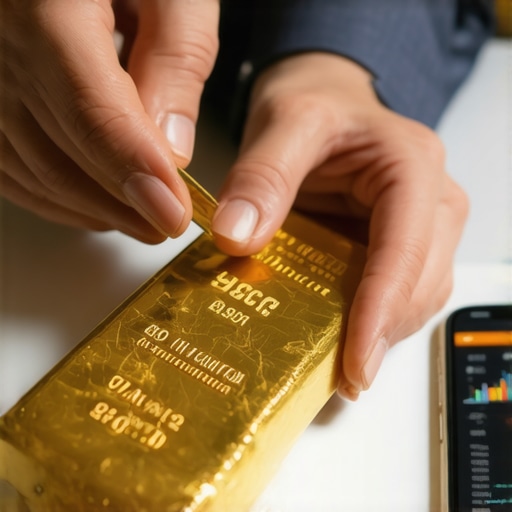Understanding Gold Investment: A Beginner’s Guide
Investing in gold has gained significant traction over the years, particularly among those looking for a safe haven in uncertain economic climates. As a beginner, understanding the fundamentals of gold investment is crucial to making informed decisions. Here are some essential facts every novice investor should know.
The Importance of Gold as an Investment
Gold has been considered a valuable asset for centuries. Unlike paper currency, gold retains intrinsic value, making it a reliable investment during economic downturns. Investors often turn to gold as a hedge against inflation and currency fluctuations. This characteristic solidifies gold’s status as a critical component in a diversified investment portfolio.
Types of Gold Investments
There are several ways to invest in gold, each with its advantages and disadvantages. The most common methods include:
- Physical Gold: This includes gold coins, bars, and jewelry. Physical gold provides tangible ownership but requires secure storage and insurance.
- Gold ETFs: Exchange-Traded Funds (ETFs) track the price of gold and allow investors to buy shares without holding the physical metal. This option is more liquid and easier to trade.
- Gold Mining Stocks: Investing in companies that mine gold can offer exposure to price movements without direct investment in gold itself. However, this comes with higher risks, including operational and market risks.
Evaluating Gold Prices
Understanding how gold prices fluctuate is vital for making successful investments. Gold prices are influenced by various factors, including geopolitical events, supply and demand dynamics, and economic indicators. Resources such as historical analysis and future outlooks can provide valuable insights into price trends.
Common Mistakes to Avoid
As a beginner, it’s easy to fall into traps that seasoned investors have learned to avoid. Here are a few common mistakes:
- Not Diversifying: Relying solely on gold can increase risk. Consider diversifying your portfolio with other assets.
- Emotional Investing: Avoid making impulsive decisions based on market hype or fear. Stick to your investment strategy.
- Ignoring Research: Always conduct thorough research before making investment decisions. Knowledge is power in the investment world.
For a comprehensive understanding of gold investment, consider exploring resources like essential considerations for beginners and top investment strategies for 2025. By arming yourself with knowledge, you can navigate the gold market more effectively and make informed choices.
Analyzing Gold Market Trends: Key Insights for Investors
To successfully invest in gold, it’s essential to analyze current market trends. Understanding the dynamics of the gold market allows investors to make informed decisions, mitigating risks associated with price fluctuations. Key trends to watch include global demand shifts, central bank policies, and geopolitical factors that can influence gold prices.
Global Demand for Gold: How It Affects Prices
Global demand for gold is a significant driver of its price. Demand can be segmented into various categories, including jewelry, investment, and industrial use. The comprehensive overview of gold demand trends provides insights into how these categories evolve over time, particularly during economic fluctuations. For instance, during economic downturns, investment demand often increases as gold is viewed as a safe haven.
The Role of Central Banks in Gold Investment
Central banks play a crucial role in the gold market by buying and holding significant quantities of gold reserves. Their actions can influence gold prices dramatically. For example, if a central bank announces plans to increase its gold reserves, it can lead to higher prices due to anticipated demand. Understanding how central bank purchases affect the gold market is vital for investors looking to gauge future price movements.
Geopolitical Factors Impacting Gold Prices
Geopolitical events, such as conflicts, trade wars, and economic sanctions, can create uncertainty in global markets, driving investors towards gold as a safe-haven asset. Monitoring current events and their potential impacts on gold prices can help investors make timely decisions. Resources like impacts of geopolitical events on the gold price offer valuable context for understanding these fluctuations.
Strategies for Investing in Gold: Best Practices
When investing in gold, implementing effective strategies can enhance your returns and minimize risks. Here are some best practices to consider:
Diversifying Your Gold Investments
Diversification is crucial in any investment strategy. By spreading your investments across different forms of gold, such as physical gold, ETFs, and mining stocks, you can reduce risk and increase potential returns. For instance, combining gold mutual funds with physical gold can balance the volatility of the market.
Staying Informed: Market Research and Analysis
Continuous market research is essential for any investor. Stay updated on gold price forecasts, trends, and expert insights to make informed decisions. Resources like the gold price forecast for 2025 provide projections that can guide your investment choices.
Understanding Your Investment Goals
Before diving into gold investment, clearly define your financial goals. Are you looking for short-term gains, or are you focusing on long-term wealth preservation? Understanding your objectives will help tailor your investment strategy effectively. For those new to investing, the beginner’s guide to investing in gold is an excellent starting point.
By applying these strategies and staying informed about gold market trends, you can optimize your investment portfolio and navigate the complexities of gold investment with confidence.
Understanding the Different Types of Gold Investments
When considering gold investments, it’s essential to recognize the variety of options available. Each type of gold investment carries its unique advantages and risks. For instance, physical gold includes items like coins and bars, which can serve as a tangible asset. On the other hand, gold ETFs provide a way to invest in gold without having to store it physically, appealing to those who prefer a more managed approach.
Investing in Gold Coins: A Beginner’s Guide
Gold coins are a popular choice for both new and experienced investors. They often come with historical value and can be easier to trade than other forms of gold. The top reasons to buy gold coins include their liquidity, potential for appreciation, and the enjoyment of collecting. However, investors should be aware of the premiums associated with coins, which can affect overall returns.
Gold Mining Stocks: Balancing Risks and Rewards
Investing in gold mining stocks offers a unique opportunity to gain exposure to the gold market. Unlike physical gold, mining stocks can provide dividends and growth potential tied to a company’s performance. However, they also carry risks related to operational challenges and market fluctuations. Resources like the risks and rewards of gold mining stocks can help investors understand the complexities involved in this form of investment.
Key Considerations for Gold Investment
When investing in gold, several factors should guide your decisions to ensure a successful investment strategy. Here are some critical considerations:
Market Timing and Price Monitoring
Understanding market timing can significantly impact your investment success. Monitoring gold price trends and making strategic purchases during dips can optimize returns. For insights on future price movements, consider resources such as evaluating gold price predictions. Staying informed allows investors to make better timing decisions.
Assessing Economic Indicators
Economic indicators such as inflation rates, interest rates, and currency strength can influence gold prices directly. For instance, rising inflation often drives investors toward gold as a hedge. By keeping an eye on how economic shifts impact future gold prices, investors can better position themselves to take advantage of market movements.
Understanding Investment Vehicles: Physical Gold vs. Gold ETFs
Deciding between investing in physical gold and gold ETFs is a crucial choice for investors. Physical gold provides the advantage of ownership of a tangible asset, while gold ETFs offer liquidity and lower transaction costs. Understanding the differences and benefits of each will help investors tailor their strategies to fit their personal preferences and financial goals. For further information, explore the comparison of physical gold vs. gold ETFs.
By considering these factors and aligning them with your financial goals, you can develop a robust gold investment strategy that minimizes risks and maximizes potential returns.
Strategies for Maximizing Gold Investment Returns
To achieve the best outcomes in your gold investment journey, it’s important to employ strategic approaches tailored to current market conditions. Here are some key strategies to consider:
Diversifying Your Gold Portfolio
Diversification is crucial in reducing risk and enhancing potential returns. By investing in a mix of different types of gold investments, such as physical gold, gold mining stocks, and gold ETFs, you can create a balanced portfolio. This strategy mitigates the impact of market volatility and optimizes your overall investment performance.
Staying Informed on Gold Market Trends
Keeping up with the latest news and trends in the gold market can provide valuable insights for making informed decisions. Resources like gold market analysis can help you understand investor behavior and anticipate price movements. Regularly updating your knowledge ensures that you remain ahead of the curve and can adjust your strategy accordingly.
Utilizing Technical Analysis for Trading Gold
For those interested in trading gold, employing technical analysis can be an effective tool. Analyzing price charts, patterns, and indicators allows investors to identify potential entry and exit points. Resources like analyzing gold price movements provide essential techniques for both novice and experienced traders to enhance their trading strategies.
Evaluating Your Gold Investment Performance
Regularly assessing your gold investments is vital to ensure they align with your financial objectives. Here are some tips for effective evaluation:
Monitoring Your Investment Returns
Tracking the performance of your gold investments allows you to gauge their effectiveness. Calculate your returns by comparing the current value against your initial investment. This analysis helps you determine whether to hold, sell, or reinvest your gold assets. Tools and resources such as evaluating your gold investment portfolio can guide you in this process.
Adjusting Your Strategy Based on Market Conditions
The gold market can be influenced by various factors, including economic shifts and geopolitical events. As a result, it’s essential to be flexible and adjust your investment strategy as needed. For example, during times of economic uncertainty, gold often becomes a safe haven. Understanding how geopolitical events impact gold prices can inform your decision-making process.
Setting Realistic Investment Goals
Establishing clear, realistic investment goals is crucial for your success. Define what you aim to achieve with your gold investments, whether it’s capital appreciation, wealth preservation, or portfolio diversification. Regularly revisit and adjust these goals to stay aligned with your evolving financial landscape and market conditions.
By implementing these strategies and continuously educating yourself about the gold market, you can enhance your investment journey and position yourself for success in 2025 and beyond.
Frequently Asked Questions About Gold Investment
What are the different types of gold investments available?
Investors can choose from various types of gold investments, including physical gold (jewelry, coins, bars), gold mining stocks, gold exchange-traded funds (ETFs), and gold mutual funds. Each type offers different risk levels and potential returns, allowing investors to tailor their portfolios.
How can I determine the best time to invest in gold?
The best time to invest in gold depends on market conditions, economic indicators, and geopolitical events. Monitoring these factors and utilizing technical analysis can help you identify potential entry points. Additionally, staying informed about gold market trends can guide your timing decisions.
Is gold a good investment during economic downturns?
Yes, gold is often considered a safe haven during economic downturns. Its intrinsic value and historical performance make it a popular choice for investors seeking stability when traditional markets are volatile. During such times, demand for gold typically increases, potentially driving up prices.
What are the risks associated with investing in gold?
While gold can be a stable investment, it is not without risks. These include market volatility, price fluctuations, and geopolitical influences. Additionally, physical gold investments may incur storage and insurance costs. It’s essential to assess these risks and develop a strategy that aligns with your financial goals.
How do I store physical gold securely?
Secure storage is vital for safeguarding physical gold investments. Options include safe deposit boxes at banks, home safes, or specialized storage facilities. Each option has its pros and cons, and it’s important to choose a method that balances security and accessibility.
What should I consider when selling my gold investments?
When selling gold, consider market conditions, your investment goals, and the potential tax implications. It’s advisable to evaluate current gold prices and consult with a financial advisor or expert to determine the best time and method for selling your gold assets.
Can I invest in gold through my retirement account?
Yes, you can invest in gold through certain retirement accounts, such as a Self-Directed IRA (SDIRA). This allows you to hold physical gold or gold-related assets while benefiting from tax advantages. Be sure to research the rules and regulations surrounding retirement account investments in gold.
How often should I review my gold investment portfolio?
It’s recommended to review your gold investment portfolio at least annually or whenever significant market changes occur. Regular assessments help ensure that your investments align with your financial goals and allow for timely adjustments based on market conditions.
What is the historical performance of gold as an investment?
Historically, gold has demonstrated a strong performance over the long term, often increasing in value during times of economic uncertainty. While past performance does not guarantee future results, many investors view gold as a reliable store of value and a hedge against inflation.
Authority Resources for Gold Investment Insights
To enhance your knowledge and stay informed about gold investments, consider exploring the following trusted resources:
- Kitco – A leading source for precious metals news, analysis, and data.
- World Gold Council – A comprehensive resource for gold market research, statistics, and investment insights.
- Investopedia – A well-regarded financial education website offering articles and guides on gold investments and strategies.
- Bloomberg – Provides up-to-date information on market trends, including gold prices and economic indicators.
- Forbes – Features expert opinions and articles on investing in gold and other precious metals.
Conclusion
In conclusion, investing in gold offers a range of opportunities for enhancing your financial security and achieving long-term wealth. By employing effective strategies, staying informed about market trends, and regularly evaluating your investments, you can navigate the complexities of gold investing with confidence. Whether you’re new to gold investment or looking to refine your approach, the insights and resources provided in this article can help you position yourself for success in 2025 and beyond. Remember, gold remains a valuable asset in uncertain times, and understanding the market landscape is essential for maximizing your returns.











I’ve recently started learning about gold investment, and this guide has been incredibly helpful in clarifying the basics. One aspect I find particularly important, which the post highlights well, is the necessity of diversification. At first, I thought sticking solely to physical gold would be safest, but I realize now that incorporating ETFs and possibly mining stocks could balance risk and potential returns better. However, I’m still unsure about how to weigh the risks of gold mining stocks against the relative stability of physical gold or ETFs, especially with the higher operational risks involved. Also, the note about emotional investing really resonated with me—it’s easy to get swayed by market hype, but having a clear strategy is essential. For those who have been investing in gold for a while, how do you balance your portfolio among physical gold, ETFs, and mining stocks? Do you find one type outperforms the others during specific economic conditions, or is it more about personal risk tolerance? I’d love to hear others’ approaches or resources they’ve found useful for managing these investment types effectively.
Diana raised some great points about balancing the risks between gold mining stocks and more stable forms like physical gold or ETFs. From my experience, physical gold acts as a solid foundation in a portfolio because it holds intrinsic value regardless of market volatility. That said, it requires secure storage and isn’t as liquid as ETFs. Gold ETFs provide a convenient way to stay involved in the gold market without the hassle of physical ownership, but they don’t offer the tangible feel of actual gold coins or bars.
Mining stocks can add growth potential but, as you mentioned, come with operational risks that aren’t directly tied to gold prices—things like management decisions or geopolitical instability can impact those companies significantly. I personally allocate a smaller portion of my gold investments to mining stocks, using them more as a tactical play rather than core holdings.
One thing that helps me manage these risks is regularly reviewing market trends and economic indicators mentioned in the article, like central bank activities and inflation data. They often hint at when gold-related assets might outperform.
Has anyone found effective strategies for adjusting their gold investment mix during shifting economic climates? For instance, do you lean more on ETFs during uncertain times for liquidity, or on physical gold for security? I’d love to hear diverse experiences on that balance!